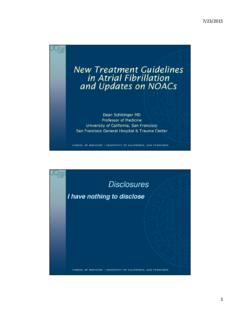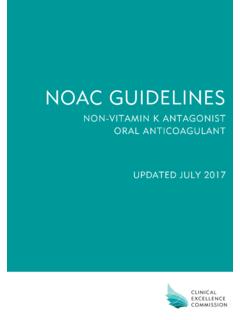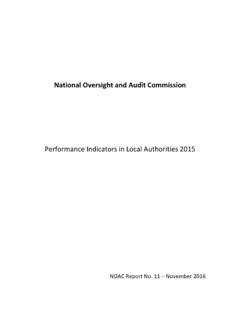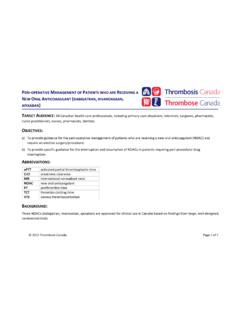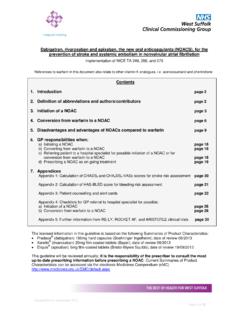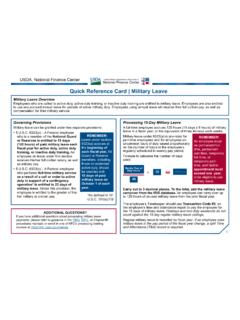Transcription of Ultrasound-guided fine-needle aspiration biopsy of thyroid ...
1 Vol.:(0123456789)1 3J Endocrinol Invest DOI fine - needle aspiration biopsy of thyroid nodules in patients on oral anticoagulantsE. Grandone1 D. Barcellona2 D. Colaizzo1 F. Marongiu2 Received: 29 December 2016 / Accepted: 2 January 2017 Italian Society of Endocrinology (SIE) 2017recommended not stopping any antithrombotic drugs before USGFNAB. In their article Lyle and Dean extend this advice to the so called NOACs (non-vitamin K oral anticoagulants), direct inhibitors of coagulation acting on FII or FXa that are on the market since 2010. These authors recommend not interrupting AVK or low-molecular weight heparins (LMWHs), as well as NOACs prior to or follow-ing an the other hand, in a review published in the J Ultra-sound Med in 2011, authors clearly recommended to take the patient off the anticoagulant for an appropriate amount of time before and after the biopsy [4].
2 They recommend stopping the warfarin for 5 days, performing biopsy if the international normalized ratio is less than to If the patient is taking LMWHs such as enoxaparin sodium, the medication should be stopped for 12 h. Alternatively, when physicians determine it s more safe for the patient to remain anticoagulated, they should give the advice to stop the patient s warfarin 2 days before the biopsy and at that time (2 days before it) begin enoxaparin subcutaneously every 12 h (bridging procedure). Warfarin may be restarted the day after the fine - needle aspiration with the patient contin-uing to receive enoxaparin until the INR becomes therapeu-tic (2 3 range).
3 In this last case, authors suggest to clearly explain to the patient that with this regimen that there is a mildly increased risk of bleeding. As discussed in the Lyle article, data in regards to patients on AVK undergoing FNA are scarce and retrospective in nature. Notwithstanding, they show a low incidence of hemorrhage, experts in the field recommend to withdraw AVK before this procedure. We believe that the bridging procedure is safer than AVK suspension for 5 days because a too large period without anticoagulation is unacceptable for many patients at a high risk for thromboembolism. On the other hand, patients on AVK may have an unpredictable risk of serious bleeding.
4 Dear Editor,We would like to comment some aspects regarding the management of patients on oral anticoagulants that need a fine - needle aspiration biopsy of thyroid nodules . In a recently published article, Lyle and Dean reviewed avail-able data on the risk of bleeding related to the very com-mon procedure of Ultrasound-guided fine - needle aspira-tion biopsy (FNA) [1]. This procedure is rarely associated with bleeding, although there are some reports of serious hemorrhagic consequences. Very rare but potentially life-threatening adverse events, as an airway obstruction due to hematomas, or pneumothorax may be provoked by acciden-tal penetration of the dome of the pleura [2].
5 For these reasons, the risk of bleeding needs to be always minimized, particularly in those patients taking antithrombotic or anticoagulant medications. On the other hand, Lyle and Dean underline that clinicians need to take always into account the potential risk of thrombotic events due to the discontinuation of such drugs. Presently, lim-ited data exist in regard to the management of anticoagu-lant therapy around the time of thyroid FNA. Retrospec-tive data obtained in 593 patients undergone USGFNAB, document 2 hematomas in those on as compared to 4 observed in those who did not take antithrombotic drugs ( = , P = ) [3].
6 Based on these findings, authors * E. Grandone Unit di Aterosclerosi e Trombosi, Casa Sollievo della Sofferenza , Viale Cappuccini, 71013 San Giovanni Rotondo, FG, Italy2 Dipartimento di Scienze Mediche Internistiche, University of Cagliari, Cagliari, Italy J Endocrinol Invest1 3 However, at the same time, Lyle and Dean do not suggest any particular care when patients are on NOACs. As pre-viously observed, NOACs have been available by prescrip-tion since 2010 (dabigatran was the first to be introduced on the market in the US and licensed in Europe in 2011), and only recently evidence has been accumulating about the management of patients on NOACs before and after surgery or invasive procedures [5, 6].
7 These drugs have a shorter half-life as compared to AVK as they are renally excreted, mainly the dabigatran etexilate, and so dose adjustment is necessary for patients with renal impairment. To date, few recommendations are available regarding the management of patients on NOACs before invasive proce-dures and they are not based on ad hoc studies. Thus, avail-able recommendations are purely based on pharmacokinet-ics features of each medication. Since FNA is a non-urgent procedure, patients should be asked about the time of the last administration of NOACs. Accordingly, the procedure should be performed at trough level.
8 Moreover, glomerular filtration rate (using Cockcroft Gault formula) especially if they are on dabigatran etexilate, should be computed. Nev-ertheless, in a recent review published by the International Society Haemostasis and Thrombosis [6] the last dose of NOAC should be taken, by patients with normal renal func-tion or with a mild or moderate renal insufficiency, 2 days before a procedure with a low bleeding risk, such as, in general, FNA procedures. No bridging is recommended. Thus, since FNA is to be considered a low risk procedure, we agree with this suggestion as while these drugs have both a predictable onset of action and half-life, a variabil-ity does exist among patients [7, 8].
9 Hence, it could happen that an endocrinologist might be faced with a patient with a low or high anticoagulant activity even at trough level. Measure of NOAC activity pre-procedure may be of utility. Laboratory tests for detecting plasma levels of NOAC are now available [9]. The anticoagulant activity of these drugs can be measured by relatively simple functional assays for both antithrombin (dabigatran) and anti-Xa (rivaroxaban and apixaban) activities. The dilute thrombin time (dTT) and the anti-factor Xa assays, calibrated for rivaroxaban, apixaban or edoxaban, may be very useful for detecting even minimal anticoagulant activity of these drugs.
10 These tests can be easily implemented in an automatic coagulom-eter even in a non specialized laboratory [10].Acknowledgements We thank Dr. Michela Massa for her helpful with ethical standards Conflict of interest All authors declare they have no conflict of approval Authors follow ethical research guidelines, according to declaration of consent Informed consent is obtained by each 1. Lyle MA, Dean DS (2015) Ultrasound-guided fine - needle aspi-ration biopsy of thyroid nodules in patients taking novel oral anticoagulants. thyroid 25:373 376 2. Hor T, Lahiri SW (2008) Bilateral thyroid hematomas after fine - needle aspiration causing acute airway obstruction.

